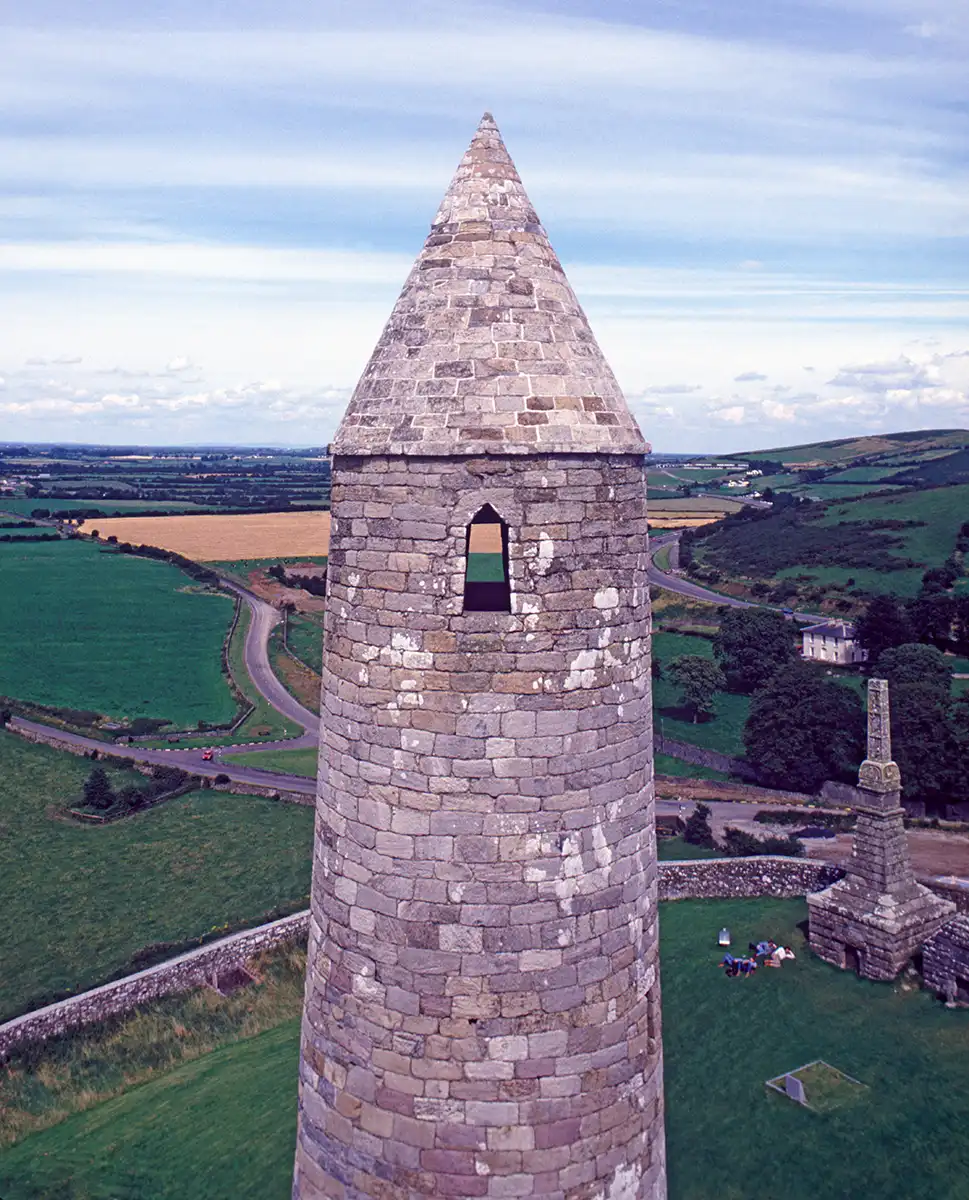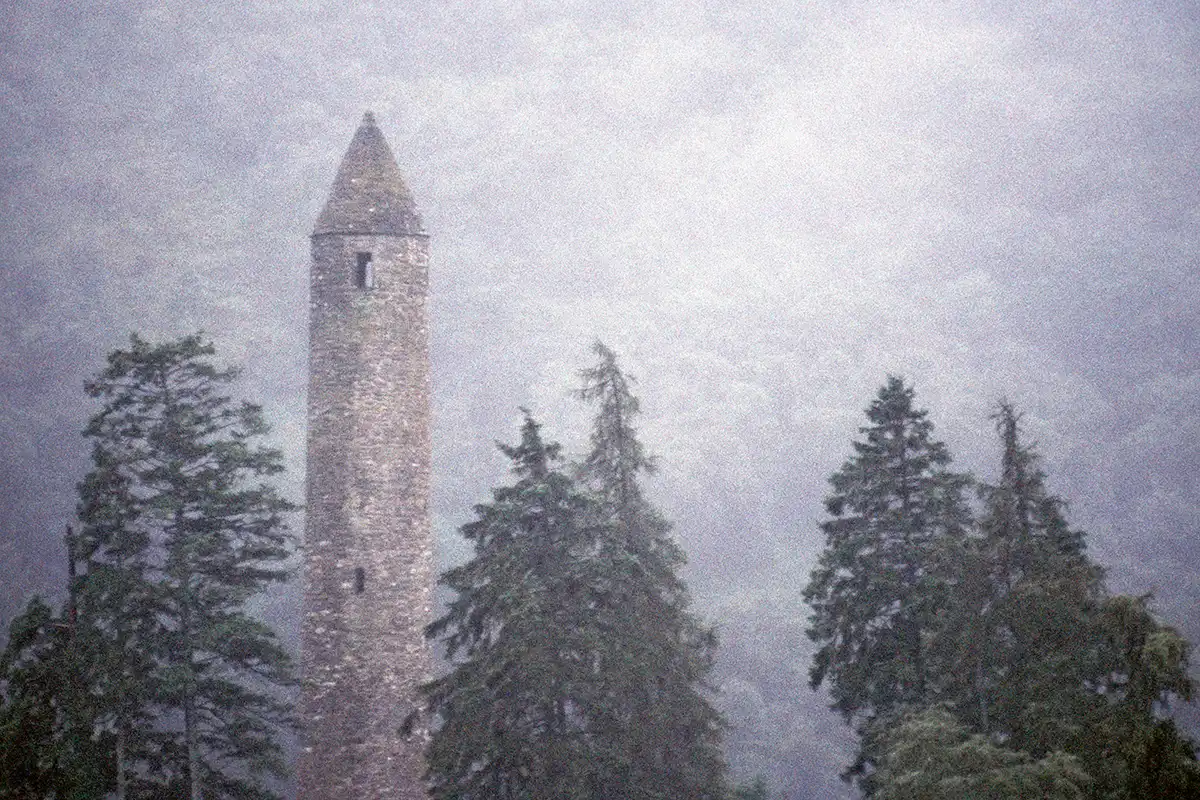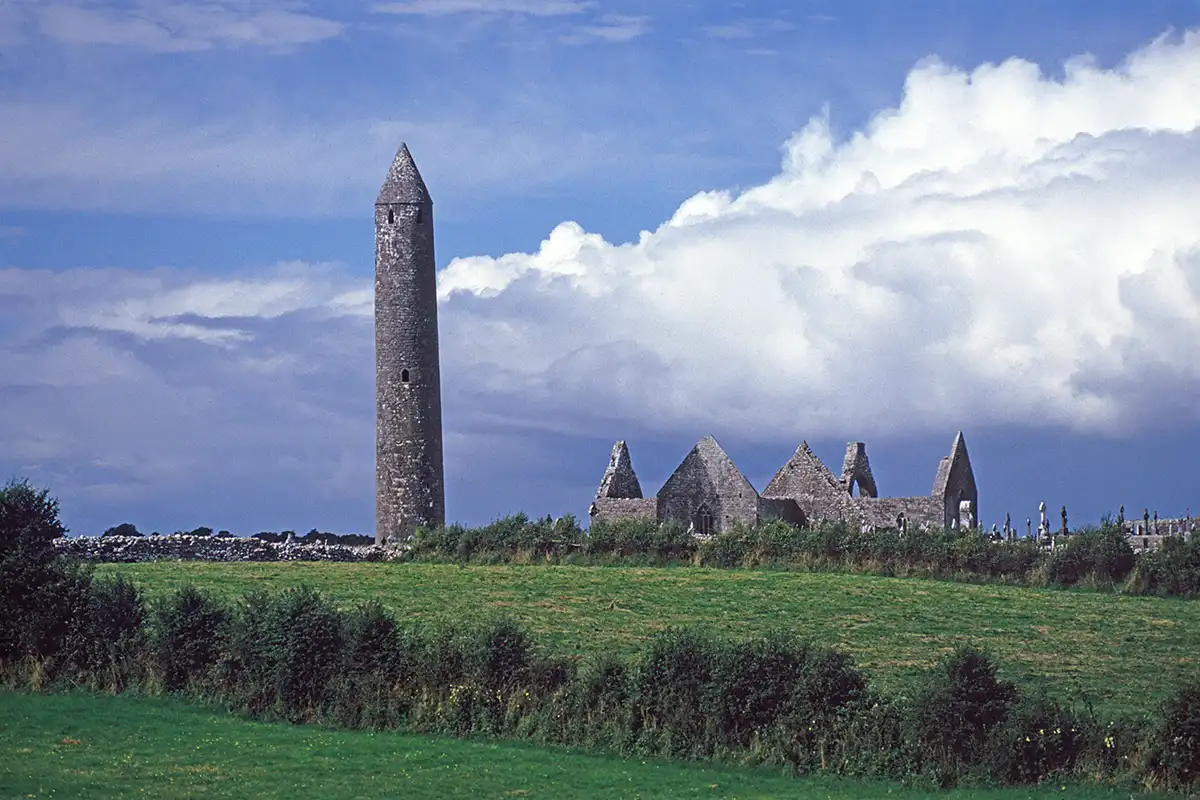The Round Towers of Ireland
Scattered with seeming randomness across the rolling hills of Ireland are the remains of sixty-five round towers. Soaring as high as 34 meters above the ground, the towers are in excellent condition, considering the antiquity of their construction. When exactly the towers were constructed is unknown. Scholars have suggested that the most probable construction period was between the 7th and 10th centuries AD, and this hypothesis is based on the fact that nearly every tower is at the site of a known Celtic church dating from the 5th to 12th centuries. Initially, each of the towers was a freestanding structure, but later, other buildings, primarily churches and monastic foundations, were constructed around some of the towers.
Thirteen towers retain a conical cap, and it is assumed that all the other towers once had similar caps that have fallen over the centuries. On a small number of towers, battlements have been built on the top, but it is known that these battlements were added at a later date in the Middle Ages. The principles used in the construction of the towers are always the same: two walls of block and mortar construction are built a few feet from one another, and the space between is filled in with a core of rock rubble. This was a standard method of wall construction utilized by the Romans. Scholars believe that Christian missionaries learned the technique in England or continental Europe and then brought the building technology to Ireland, incorporating it in the building of the massive round towers..
Writing of the dimensions of the towers in his book, Irish Round Towers, Lennox Barrow states: "It is remarkable how little the main dimensions vary. In the great majority of towers the circumference at the base lies between 14 meters and 17 meters and the thickness of the wall at the lowest point at which it can be measured varies from 0.9 meters to 1.4 meters. Doorways, windows, storey heights and diameters also follow clearly defined patterns, and we may well conclude that most of the towers were the work of teams of builders who moved from one monastery to another using standard designs." Barrow goes onto say that: "Most doorways are raised1.5 meters to 4.5 meters above the ground.This is usually explained as being for security, to enable the monks to take refuge inside the towers during times when Viking raiders or bandits were attacking the monasteries. There is probably some truth in this theory but t is possible that the stability of the tower had as much to do with the door heights. The higher you could build before making an opening in the wall the stronger the base would be. Very often the towers were filled in, even as high as the doorways."
This idea that the round towers were erected and used primarily as watch towers and places of protection is debated by an American scientist, Philip Callahan. In his book Ancient Mysteries, Modern Visions, Callahan discusses research that indicates that the round towers may have been designed, constructed, and utilized as huge resonant systems for collecting and storing meter-long wavelengths of magnetic and electromagnetic energy from the earth and skies. Based on fascinating studies of the forms of insect antenna and their capacity to resonate to micrometer-long electromagnetic waves, Professor Callahan suggests that the Irish round towers (and similarly shaped religious structures throughout the ancient world) were human-made antenna that collected subtle magnetic radiation from the sun and passed it on to monks meditating in the tower and plants growing around the tower's base. The round towers were able to function in this way because of their form and also because of their materials of construction.
Of the sixty-five towers, twenty-five were built of limestone, thirteen of iron-rich, red sandstone, and the rest of basalt, clay slate, or granite - all of these being minerals that have paramagnetic properties and can thus act as magnetic antenna and energy conductors. Callahan further states that the mysterious fact of various towers being filled with rubble for portions of their interiors was not random but rather may have been a method of "tuning" the tower antenna so that it more precisely resonated with various cosmic frequencies.
Equally intriguing, Callahan shows that the seemingly random geographical arrangement of the round towers throughout the Irish countryside mirrors the stars' positions in the northern sky during the winter solstice. Archaeological excavations at the bases of the towers have revealed that many towers were erected upon the tops of much older graves, and it is known that many of the tower sites were considered sacred places long before the arrival of Christianity in Ireland. These facts compel us to wonder if the ancient Irish, like the Egyptians, the Mayans, and many other archaic cultures, understood there to be an energetic resonance between specific terrestrial locations and different celestial bodies. This certainly seems to be the case. All across the Irish countryside, particular locations were chosen, precisely designed structures were erected to gather and store various energies, and a tradition of humans' spiritual use of the sites arose over the millennia. While many of the round towers are now crumbling, and their antenna function may no longer be operative, a field of holiness still permeates the sites today.
In another article (The Mysterious Round Towers of Ireland: Low Energy Radio in Nature; The Explorer's Journal; Summer, 1993) Callahan gives further details of his discoveries:
"Most books will tell you that the towers were places of refuge for the monks to hide from Vikings raiding Ireland. They were, no doubt, bell towers and lookouts for approaching raiders, but the speculations that monks escaped raiders, who no doubt knew how to smoke bees out of hives or climb the 9 to 15 feet to the door, borders on the ludicrous. Round towers are perfectly designed to be totally useless for hiding people or church treasures.....Another strange thing about the towers is the dirt that fills the base below the high doors. Each door has a different level of dirt filling the base as if they were "tuned" like a pipe organ....I had long postulated that the towers were powerful amplifiers of radio resonance from the atmosphere generated by lightning flashes around the world.....The round towers proved to be powerful amplifiers in the alpha brain wave region, 2 to 24 Hz, in the electrical anesthesia region, 1000 to 3000 Hz, and the electronic induction heating region, 5000 Hz to 1000 KHz....It is fascinating that just above the surface of the ground to about 2 to 4 feet up there is a null of atmospheric frequencies that get stronger and stronger until at 9 to 15 feet above the surface they are extremely strong. The Irish monks were well aware of this for that is where they built their high doors. At every tower we measured there was a direct correlation between tower door height and the strongest waves.....That the highly amplified waves occur in the meditative and electrical anesthesia portion of the electromagnetic spectrum is of utmost significance. In 1963, G. Walter researched brain EEG waves from 0.5 to 3 Hz (Delta region) and found anti-infectious effects. There is an elegant but short list of research projects demonstrating the beneficial effects of low ELF wavelengths on sick people."
Round tower of Cashel
Jutting high above the plain of Tipperary against the backdrop of the Galtee mountains is the 28-meter round tower of Cashel. While the tower dates from the 11th century, the rock outcrop upon which it stands has fortifications from the early 4th century when it was the stronghold and ceremonial center of a powerful clan. Patrick is said to have visited the site in 450 AD; hence, one of its popular names is Saint Patrick's Rock.
Round Tower of Glendalough
The tower of Glendalough is considered by scholars to be the most finely constructed and beautiful tower in all of Ireland. Situated in the cleft of a steep and thickly forested valley, the 30-meter tall tower is built of mica schist with a granite doorway. Glendalough was an ancient gathering place of pre-Christian hermits, and the first Christian monastery was established by Saint Kevin, who lived in the enchanted valley from 498-618 AD. Clustered about the base of the tower are remains of a 1200-year-old cathedral and the first functioning university in the Western world. Nearby the tower is the healing cross of Saint Kevin. A local legend states that if one encircles the cross with one's arms and makes a wish concerned with healing, that wish will be fulfilled according to the depth of one's love of God.
Round Tower of Kilmacduagh
Kilmacduagh, north of Limerick in county Galway, is the tallest of the Irish towers at 34 meters and, while stable, appears to be tilting precariously. Little is known of the adjoining monastery, probably founded in the early 7th century, and it is assumed that the round tower was erected sometime in the 10th or 11th centuries.
The Esoteric Significance of the Round Towers of Ireland
The round towers of Ireland stand as enigmatic sentinels of a bygone era, their slender, cylindrical forms piercing the sky across the Irish landscape. These structures, numbering around 65 in various states of preservation, have long captivated historians, archaeologists, and esoteric scholars alike. Dating primarily from the 9th to the 12th centuries, they are often associated with early Christian monastic settlements, yet their true purpose and symbolic meaning remain shrouded in mystery. Beyond their apparent utility as bell towers, storage spaces, or defensive refuges during Viking raids, the round towers possess a deeper, esoteric significance that ties them to ancient cosmological, spiritual, and architectural traditions. This essay explores the hidden meanings of these towers, weaving together their historical context, architectural peculiarities, and their resonance with pre-Christian mysticism, sacred geometry, and the perennial wisdom of Ireland’s past.
Historical Context and Conventional Interpretations
To understand the esoteric significance of the round towers, one must first consider their historical backdrop. Constructed during Ireland’s Early Medieval period, these towers emerged during a time of transition, when Christianity was overlaying and integrating with the island’s older, pagan traditions. Typically ranging from 20 to 40 meters in height, the towers feature a distinctive conical cap and a doorway elevated several meters above the ground, accessible only by ladder. Traditional scholarship posits that they served practical purposes: as belfries (hence the Irish term cloigtheach, meaning “bell house”), storehouses for sacred relics, or watchtowers against invaders. Their association with monastic sites like Clonmacnoise, Glendalough, and Kells reinforces this ecclesiastical narrative.
However, these utilitarian explanations fail to account for the towers’ peculiar design and distribution. Why build such tall, narrow structures with inaccessible entrances if their sole purpose was to ring bells or store goods? Why do they appear almost exclusively in Ireland, with few parallels elsewhere in Europe? These questions have fueled alternative interpretations, suggesting that the towers are more than mere architectural relics—they are symbols of a profound spiritual legacy, bridges between the material and the metaphysical.
Architectural Symbolism and Sacred Geometry
The round towers’ most striking feature is their circular form, a shape laden with esoteric meaning across cultures. In sacred geometry, the circle represents unity, eternity, and the divine. Unlike the square, which anchors itself to the earthly plane, the circle transcends linearity, evoking the cyclical nature of time and the cosmos. The towers’ cylindrical design can thus be seen as a microcosm of the universe, a vertical axis mundi connecting the terrestrial to the celestial. Their conical caps further enhance this symbolism, resembling a stylized mountain or pyramid—a common motif in ancient traditions for channeling divine energy downward.
The elevated doorways, often interpreted prosaically as a defensive measure, take on a different significance in an esoteric light. Positioned several meters above ground, they suggest a threshold between worlds, a portal accessible only to the initiated. In many mystical traditions, height and ascension symbolize spiritual elevation; the ladder to the doorway becomes a metaphor for the soul’s journey toward enlightenment. This aligns with the towers’ monastic context, where monks pursued lives of contemplation and communion with the divine. The round towers, then, may have been physical and symbolic ladders to the heavens, their circularity reflecting the eternal return of spiritual cycles.
Moreover, the towers’ proportions hint at an understanding of harmonic ratios and cosmic order. While no definitive evidence exists of deliberate mathematical design (like the Golden Ratio), their consistent height-to-diameter ratios and careful stonework suggest a builders’ intuition—if not explicit knowledge—of sacred proportions. This resonates with the broader Celtic reverence for nature’s patterns, evident in the spirals of Newgrange or the knotwork of illuminated manuscripts like the Book of Kells.
Pre-Christian Roots and Cosmic Alignment
The esoteric significance of the round towers deepens when viewed through the lens of Ireland’s pre-Christian heritage. Before the arrival of Christianity, the island was a bastion of Druidic culture, steeped in animism, astronomy, and oral tradition. The Druids, as priestly and intellectual custodians, were attuned to the movements of the stars and the rhythms of the earth. Some scholars, notably 19th-century antiquarian Henry O’Brien in his controversial work The Round Towers of Ireland, argue that the towers predate Christianity and were originally pagan structures repurposed by the Church. O’Brien linked them to phallic symbols of fertility and solar worship, drawing parallels with obelisks in Egypt or stupas in India.
While O’Brien’s theories are speculative and lack archaeological support, they highlight an undeniable continuity between Ireland’s pagan and Christian eras. The towers’ locations often coincide with ancient sacred sites—springs, hilltops, or places of prehistoric ritual. For instance, the tower at Glendalough sits within a valley long revered as a spiritual center, while the one at Monasterboice aligns with a landscape rich in megalithic remnants. This suggests that the towers may have been built to sanctify or Christianize existing holy places, preserving their sanctity while adapting their meaning.
Astronomical alignment offers another layer of esoteric intrigue. Though not as overtly oriented as Stonehenge, some towers appear to correlate with celestial events. The doorway of the Kildare tower, for example, faces northeast, toward the rising sun at the summer solstice—a direction significant in both pagan and Christian cosmology. Such alignments hint that the towers served as markers of time and space, harmonizing human activity with the cosmic order. In this sense, they echo the Druidic worldview, where the land, sky, and spirit were inseparable.
Mystical Functions and Energetic Resonance
Beyond symbolism, the round towers may have had practical esoteric functions tied to energy and resonance. Their height and shape suggest they could act as conductors or amplifiers, channeling subtle energies between earth and sky. In occult traditions, tall, pointed structures are believed to concentrate telluric or atmospheric forces, a concept mirrored in the use of church spires or minarets. The towers’ stone construction, often using local materials like granite or limestone, would enhance this conductivity, grounding them in the earth’s magnetic field.
Some modern esotericists propose that the towers were sites of ritual sound, their interiors designed to amplify chants or bells in a way that induced altered states of consciousness. The Irish monks, inheritors of a bardic tradition, may have used these acoustics to deepen their meditative practices, aligning their vibrations with the universe. This theory, while unproven, aligns with the towers’ association with bells—tools not just for signaling but for invoking sacred presence.
The Towers as Guardians of Hidden Knowledge
Finally, the round towers can be seen as repositories of esoteric wisdom, guarding secrets lost to time. Their inaccessibility and durability suggest they were meant to endure, preserving something intangible yet vital. In Irish mythology, towers are often linked to otherworldly beings—Tuatha Dé Danann or fairy folk—hinting at a folk memory of their sanctity. The monks who built or maintained them may have encoded their knowledge into the towers’ very stones, a silent testament to a syncretic spirituality blending Celtic mysticism with Christian theology.
In this light, the towers stand as Ireland’s equivalent to the pyramids or megaliths: monuments to a worldview that saw no division between the sacred and the mundane. They invite us to look beyond their physical form, to sense the currents of meaning flowing through their circular walls. Whether as cosmic pillars, energetic resonators, or silent sentinels, the round towers embody an esoteric significance that transcends their historical moment, whispering of a time when humanity lived in closer harmony with the unseen.
Conclusion
The round towers of Ireland are more than relics of a medieval past; they are keys to an esoteric tradition that spans millennia. Their circularity, elevation, and alignment speak to a profound understanding of the cosmos, rooted in both pagan and Christian sensibilities. While their full purpose may never be known, their presence stirs the imagination, urging us to reconsider the boundaries between history and mystery. As symbols of unity, ascension, and hidden knowledge, they remain Ireland’s enigmatic gift to the world—a testament to the enduring power of the sacred.
For additional information:

Martin Gray is a cultural anthropologist, writer and photographer specializing in the study of pilgrimage traditions and sacred sites around the world. During a 40 year period he has visited more than 2000 pilgrimage places in 160 countries. The World Pilgrimage Guide at sacredsites.com is the most comprehensive source of information on this subject.



